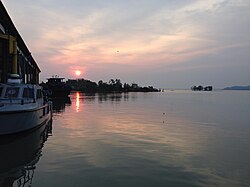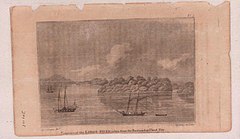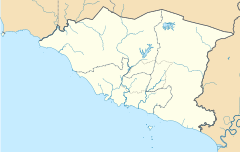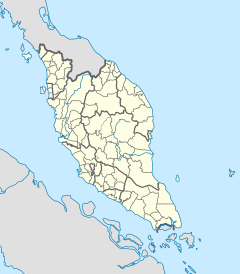Linggi River
| Linggi River | |
|---|---|
 A pier at the mouth of the Linggi, near the Negeri Sembilan-Malacca state border. | |
| Native name | Sungai Linggi (Malay) |
| Location | |
| Country | Malaysia |
| State | Negeri Sembilan and Malacca |
| Physical characteristics | |
| Source | Titiwangsa Mountains |
| • location | Pantai, Seremban District, Negeri Sembilan |
| • coordinates | 2°49′02″N 101°59′14″E / 2.8172°N 101.9872°E |
| Mouth | Strait of Malacca |
• location | Kuala Linggi, Alor Gajah District, Malacca and Kampung Tanjung Agas, Port Dickson District, Negeri Sembilan |
• coordinates | 2°23′26″N 101°58′26″E / 2.3906°N 101.9738°E |
| Length | 83.5 km (51.9 mi) |
| Basin features | |
| Tributaries | |
| • right | Semin River Rembau River |
| Bridges | Jambatan Kampung Barisan Jambatan Jalan Rantau Jambatan Kuala Linggi |
| Inland ports | Port of Kuala Sungai Linggi |
The Linggi River (Malay: Sungai Linggi) is a river in Malaysia which flows through the states of Negeri Sembilan and Malacca. It is one of two major rivers that serve as water sources for most of Negeri Sembilan's population, the other being the Muar River, which constitutes the state's eastern half.
History


The Linggi, alongside the
Several conflicts took place around the river in the 19th century:
Sungai Ujong–Selangor border dispute
In 1766, the sultanate of
In 1862, he expressed objection towards the
The dispute rose again in 1866, which resulted in Sultan Abdul Samad cedes the river to Dato' Klana Sendeng as the boundary between the two territories two years later in a written statement, and it fared negative reactions from the nobles of
Klana–Bandar conflict and British intervention in Sungai Ujong
Dato' Klana Syed Abdul Rahman had been rivals with another nobleman from the same area, Dato' Bandar Abdullah Tunggal. Syed Abdul Rahman was instated as the Undang of Sungai Ujong in 1872, in the wake of the death of his uncle, Dato' Klana Sendeng. Since then, they engaged in a tight competition in spreading their influence throughout the chiefdom, as well as to gain control over the Linggi River. Speaking of areas of influence, Dato' Klana Syed Abdul Rahman's dominion covers Ampangan, Setul, Lenggeng and parts of Seremban; while Dato' Bandar Abdullah Tunggal's cover Rasah, extending northwards to Labu.
The conflict stemmed from Abdullah Tunggal's rising popularity thanks to his profitable taxations imposed in the ports along the Linggi, including Rasah. Deeming him to be a direct competitor, Syed Abdul Rahman argued with him over the taxations in Kuala Linggi. Feeling threatened, the Dato' Klana sought for British assistance in restoring his position as the ruler of Sungai Ujong. On 21 April 1874, a treaty between the Dato' Klana and the British was sealed, of which he accepted being under the protection of the British Empire, as well as assigned the settlements of Sempang to Permatang Pasir to be under British control. With this treaty effective, Capt. P.J. Murray was appointed as the first Resident of Sungai Ujong, and Syed Abdul Rahman also restored his immunity as the Undang. In addition, this also granted the British full authority to collect taxes along the Linggi, only leading to the Dato' Bandar's ire once he learned about it. In retaliation, he firmly opposed against the treaty, and to a certain degree, sent death threats to the former.
Planning an
The conflict escalates as several diplomatic attempts between Syed Abdul Rahman and Abdullah Tunggal by Pickering and his men failed. The Dato' Bandar was last seen reinforcing his fortifications in Kepayang in a 14 November visit by Pickering to Sungai Ujong. Meanwhile, the Dato' Klana has appointed a new Dato' Bandar from the same

A
The civil war lasted until 17 December, where Abdullah Tunggal surrendered himself to Syed Abdul Rahman and the British in Sungai Ujong, and was
Course

The Linggi starts from the foothills of the
Tourism

The estuary of the Linggi River is known for its biodiversity and historical significance. It hosts one of the biggest population of
Also present are the remnants of two fortresses, Fort Kuala Linggi (also known as Fort Supai and Fort Filiphina) in Kuala Linggi, and Fort Simpang in Paya Lebar, both were erected during the Dutch colonial period.
Gallery
-
Village locals fishing in the river near Mambau
-
The Linggi River near Rantau. The Titiwangsa Mountains can be seen in the background.
-
Skerries at the river's estuary
See also
References
- ^ "Projek ikan sangkar di Sungai Linggi - Wilayah - Utusan Online". www.utusan.com.my. Archived from the original on 2015-10-17.
- ^ "Pemerhati Kuala Linggi" (PDF).
- ^ "Sang Bedal sesat atas Jambatan Linggi".






